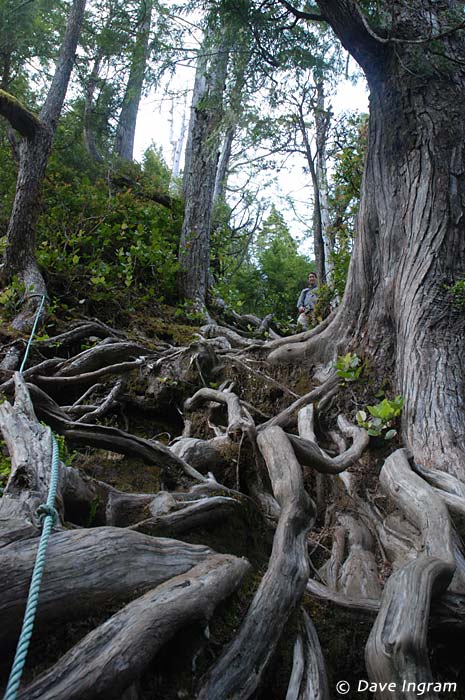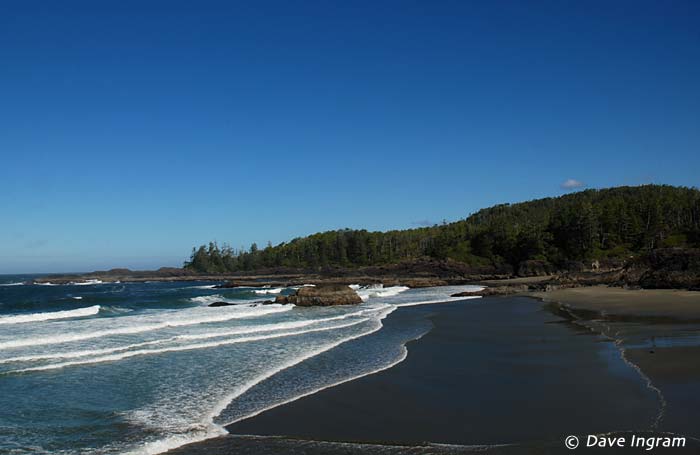Pacific Rim National Park Reserve is well known for its long, sandy, and windswept beaches. Every year over 800,000 people visit this spectacular national park. If you truly want to experience the dramatic power of this landscape, the challenge is finding a place without many people. Radar Hill beach is one such place.
When visiting Pacific Rim, I try to plan my walks for the early morning and choose trails that are a little bit longer in order to avoid the crowds. If you have to walk longer than thirty minutes, the number of people that you encounter drops off fairly quickly. Then you can begin to appreciate the beauty of the less visited places in the park.
About that “Trail” to Radar Hill Beach
I recently explored one of the unofficial trails in the park that leads from the Radar Hill viewpoint down to the Radar Hill Beach. This trail is not maintained by Parks Canada staff and those expecting an easy gravel and boardwalk stroll will be challenged immediately. The reward for your effort is an amazing beach and, at low tide, excellent opportunities for tide pool exploration.

Be forewarned. This trail is a backcountry slog with a rainforest twist. Sections of the trail are very steep and resemble a climbing wall complete with a rope and a convoluted mass of roots to assist you down and up again. Hiking boots with good ankle support are required. There are multiple places to twist an ankle on an exposed root.
In many places the trail goes over, under, or around large old fallen trees. In other parts of the trail you have to balance on top of fallen trees in order to cross over streams and gullies. And finally, there is mud and lots of it. There hasn’t been much rain recently but the trail was still very muddy in places. Allow 45 minutes of scrambling and working through mud, roots and downed trees to hike from the parking lot to the beach itself – it may take you more or less time depending on your fitness level and trail conditions.
Radar Hill Beach
This beach is worth the effort. The trail leaves the Sitka spruce and emerges into a small dune ecosystem. Typical plants here are Yellow Sand-verbena, Beach-carrot, and Seashore Lupine. Use some care in this fragile area and avoid trampling the sensitive dune plants.

Rocky headlands frame the beach and it looks out toward several smaller islands. At low tide, many of the rocky islets are surround by sand and it is possible to get good looks at a variety of intertidal life including walls of mussels, purple seastars, gooseneck barnacles, giant green surf anemones. In addition, black oystercatchers nest on the rocky islands so make sure to give them plenty of room. Above all, it is the lack of people that makes this location so special. Over the course of four hours, I saw a total of four people, and those only briefly. Opportunities to explore a beach to the south exist but beyond that rocky headlands make further travel difficult.

The route to Radar Hill Beach is a challenging “backcountry” alternative to regular trails in the park. The stunning views and isolation make it worth considering.
Need to know:
- Lower level gates to the viewpoint at Radar Hill open at 8:00am and close at 11:00pm – a Park Use Permit is required to access the parking area
- Bring food, water, and appropriate clothing and footwear for a backcountry hike
- Be aware that wildlife encounters are possible on the trail and know what to do if you meet a black bear, cougar or wolf
- A fair level of fitness, balance, and agility is required to navigate roots, trees, and muddy areas
- Visitors using this unofficial trail do so at their own risk – you are on your own


